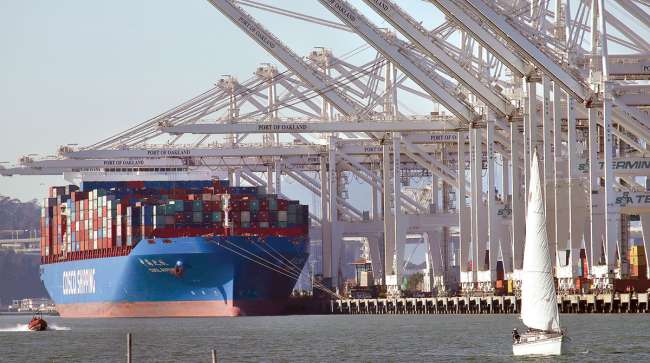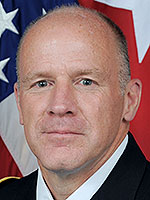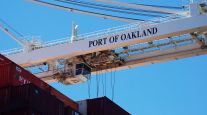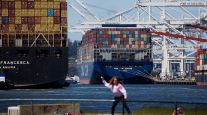Senior Reporter
White House Port Envoy Visits Port of Oakland to Discuss Cargo Downturn

[Stay on top of transportation news: Get TTNews in your inbox.]
The White House port and supply chain envoy, retired Gen. Stephen Lyons, met with Port of Oakland officials Aug. 29 at the California complex, discussing the ongoing supply chain issues, as that facility has seen a significant drop in container traffic this year.
That is due in part to shippers having passed it by because of higher shipping rates available at the ports of Los Angeles and Long Beach.
In July, the Port of Oakland recorded a 28% year-over-year decline in cargo, one reason being it was shut down for a week by independent truck drivers, who were protesting the implementation of California’s new worker classification law. Also, shippers say from a cost benefit it makes more sense to avoid going to Oakland, ship the items destined for Oakland by truck and then head back to China or another Asian port, reload and cross the Pacific again full.

Lyons
Lyons met with Port of Oakland Executive Director Danny Wan and Maritime Director Bryan Brandes to discuss the challenges Oakland’s maritime activities face and continue the federal dialogue to support solutions to goods movement.
“I am committed to looking for ways to stabilize the entire supply chain across the nation and restore consumer confidence in the system, and the Port of Oakland plays an important role in our nation’s freight network,” Lyons said.
Oakland’s drop in cargo is taking place at a time when other ports are seeing record container volumes.
While overseas shipping prices have fallen significantly from their pandemic high of more than $16,000 per 20-foot-equivalent unit, the latest Drewry’s composite World Container Index for spot rates decreased by 2% the last week of August. It marks the index’s 23rd consecutive weekly decrease, and shipping prices now are 29% below year-ago levels. Rates for the Shanghai-to-Los Angeles route fell 3% to $7,280 per 40-foot container. However, the Drewry WCI composite index for spot rates remains 84% higher than the five-year average.

Wan
Port of Oakland’s Wan said he believes Lyons’ visit to Oakland is a sign his facility is open for business and set to make a rebound.
“We fully appreciate Gen. Lyons coming to Oakland to see our operations and explore solutions to the current supply chain congestion,” Wan said in a statement. “Oakland has been a decadeslong port of choice for agricultural exports; we need to restore a full complement of services here to help all of our customers move their goods.”
As part of his visit, Lyons met with agricultural exporters, importers and maritime terminal operators who rely on the port for their business.
According to port officials, the agriculture leaders expressed concern about how their import and export operations are being disrupted at various points in the supply chain.
The White House Port and Supply Chain Envoy and Port of Oakland officials meet to discuss supply chain solutions. Read more here #portenvoy #ports #AAPA_Seaports #whitehouseportenvoy #GeneralLyons #supplychain #logistics #maritime https://t.co/JtxxOTn7S2 — Port of Oakland (@PortofOakland) August 31, 2022
Their issues include:
• Overflowing warehouses. The vacancy rate for warehouses in some parts of California is below 1%, especially near port complexes.
• The lack of labor at distribution centers,
• Continuing equipment shortages, including the lack of available chassis.
• The need for more vessel services to increase export capacity.
• The desire to move imports off marine terminals faster and reduce cargo dwell time.
In the past 18 months, the federal government and Port of Oakland have developed a closer working relationship.

Brandes
“We continue to look for creative ways to reduce port congestion and supply chain disruptions at Oakland, including building infrastructure and increased transparency of data to increase the fluidity of commerce through our port,” Brandes said.
In early March, the port, with the help of the U.S. Department of Agriculture, began setting up and operating a 22-acre, multimillion-dollar pop-up container yard specifically for agricultural exports.
It comes as food companies, port officials and government leaders seek to capitalize on the growing demand for exported American farm products. Officials said assuming the venture is successful, it could be replicated at other facilities.
Port officials said federal funding accounts for 60% of the cost to construct and operate the export container depot. Some of the money will partially cover a $125-per-container reimbursement to shippers, according to USDA.
Port Executive Director Danny Wan welcomed Port customers including exporters to yesterday's webinar on Oakland's new "pop-up" container yard. See the full press release for more information.https://t.co/NgQ1RTCJ0F #ports #exports #exporters #logistics #reefers pic.twitter.com/mWXTC64JyC — Port of Oakland (@PortofOakland) February 25, 2022
Before the COVID-19 pandemic began, the port was busiest with agriculture-specific exports, in part because of its location near central California’s rich agriculture basin and with direct rail links to the Midwest.
It serves as an export link for refrigerated protein products from farmers in Iowa, Minnesota, Illinois, Wisconsin and other Midwest states.
The Port of Oakland also in the midst of trying to lure Major League Baseball’s Oakland A’s to the port complex. A proposal could be approved later this year to build a ballpark as well as construct a multibillion-dollar real estate development near the complex.
Want more news? Listen to today's daily briefing below or go here for more info:




